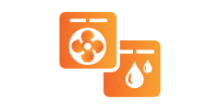Heat pumps collect heat from the air, water, or ground outside your building and concentrate it for use inside. Similar to a refrigerator, a heat pump uses a "refrigerant" fluid to transfer heat between inside and outside the building. They can also be used to concentrate heat from the air and transfer it to heat your hot water tank. This cycle of moving heat works in both directions, which is why heat pumps can act as both a heating and a cooling system. Because heat pumps move heat, rather than converting it from a fuel the way combustion systems do, they may be able to operate for less than the cost of conventional heating or cooling appliances.
Buildings that are properly air sealed and insulated are more efficient to warm or keep cool. Before you install a heat pump, you may want to consider consulting a qualified energy professional, who can assess your building's needs with an energy audit. They can also help you make a plan to choose and size a heat pump that best fits your needs. Visit the Weatherization section to learn more about Energy Audits.
There are two types of heat pumps:
- Air-source: The most common type of heat pump is the air-source, which transfers heat between your building and the outside air. Until recently, air-source heat pumps have not been used in areas that experience extended periods of subfreezing temperatures. However, air-source heat pump technology now offers a space heating alternative in colder regions called “Cold Climate Air-Source Heat Pumps.” Heat pumps now use less electricity for heating compared to electric resistance heaters and less electricity for cooling compared to standard air conditioners.
High-efficiency heat pumps can dehumidify better than standard central air conditioners, which may result in less energy usage and more cooling comfort in summer months. For buildings without existing air ducts, "ductless mini-split" air-source heat pumps are also available. These have a single outdoor "condenser unit" and one or more inside "heads" that are connected by a bundle of pipes and wires. They typically require minimal construction, as only a three-inch hole through the wall is needed to connect the outdoor condenser and the indoor head.
Single-zone systems can be designed for a single room or open area, while multi-zone installations can have two or more indoor heads connected to one outdoor condenser. Each "zone" allows you to heat or cool individual rooms, hallways, and open spaces. In addition, a special type of air-source heat pump called a "reverse cycle chiller" generates hot and cold water rather than air, allowing it to be used with radiant floor heating systems in heating mode.
A list of models that qualify for incentives may be found at the Efficiency Vermont Heat Pump Heating and Cooling web page.
- Geothermal: Water source geothermal (called "ground-source" or "water-source") heat pumps achieve higher efficiencies by transferring heat from the ground or a nearby water source to your building. Although they typically cost more to install, geothermal heat pumps can have relatively low operating costs because they take advantage of fairly constant ground or water temperatures. Geothermal heat pumps may have other specific advantages, including the ability to:
- Reduce energy use
- Control humidity
- Be sturdy and reliable
- Fit in a wide variety of buildings
- Function in more extreme climates than air-source heat pumps
- Work efficiently year-round, with no decreases in efficiency
Some Benefits
- Heat pumps can provide you with both heating in the winter and cooling in the summer
- Air source heat pumps can be easy to install and can be a very efficient way to condition specific rooms in your building
Some Considerations
- Compared to other systems, geothermal heat pumps can be expensive to install, and are generally only used in new construction projects
- Even the most efficient heat pumps will need a back-up heating system for the coldest times of year and, depending on your individual circumstance, may not be the most cost-effective choice for your building
- You may want to consider whether you are able to swap this technology out for new equipment as efficiencies improve
-
When considering an air-source heat pump, you may want to look at the EnergyGuide label, which displays the heat pump's heating and cooling efficiency performance rating, allowing you to compare it to other available makes and models. Heating efficiency for air-source electric heat pumps is indicated by the HSPF ("heating season performance factor"). Cooling efficiency is indicated by the SEER ("seasonal energy efficiency ratio"). In a colder climate such as Vermont, you may want to consider focusing more on getting the highest HSPF rating rather than the SEER rating. It is also important to install the heat pump correctly, to optimize its efficiency and avoid possible weather-related issues.
Some Next Steps
You can ask a qualified energy professional about how a heat pump may fit into your home or business energy mix. As with other energy improvements, it may be beneficial to air seal and insulate first, in order to save money on the size of your new unit.
Learn More
- Energy.gov has a section on heat pump basics
- A report evaluating Cold Climate Heat Pumps in Vermont is available on the VT Department of Public Service website
Visit the pages below to learn more about Heating & Cooling:






